http://www.spinellis.gr/pubs/conf/1997-Perf-Anneal/html/anneal.html
This is an HTML rendering of a working paper draft that
led to a publication.
The publication should always be cited in preference to this
draft using the following reference:
- Diomidis Spinellis and
Chrisoleon T. Papadopoulos.
A
simulated annealing approach for buffer allocation in reliable production
lines.
In International Workshop on Performance Evaluation and Optimization of
Production Lines, pages 365–375. University of the Aegean, Department
of Mathematics, May 1997.

Citation(s): 3 (selected).This document is also available in
PDF format.The document's metadata is available in BibTeX format.
Find
the publication on Google Scholar
This material is presented to ensure timely dissemination of
scholarly and technical work. Copyright and all rights therein are
retained by authors or by other copyright holders. All persons
copying this information are expected to adhere to the terms and
constraints invoked by each author's copyright. In most cases, these
works may not be reposted without the explicit permission of the
copyright holder.
Diomidis Spinellis Publications
|
A Simulated Annealing Approach for Buffer Allocation
in Reliable Production Lines
D. Spinellis and H. T. Papadopoulos
Department of Mathematics
University of the Aegean
GR-832 00 Karlovasi, Samos
Greece
e-mail: {dspin,hpap}@aegean.gr
April, 1997
Abstract:
We describe a simulated annealing approach for
solving the buffer allocation problem in reliable
production lines.
The problem entails the determination of near optimal buffer allocation plans
in large production lines with the objective of maximising their average
throughput.
The latter is calculated utilising a decomposition method.
The allocation plan is calculated subject to a given amount of total buffer
slots in a computationally efficient way.
Buffer allocation is a major
optimisation problem faced by manufacturing systems designers.
It has to do with
devising an allocation plan for distributing a certain amount of buffer space among
the intermediate buffers of a production line. This problem is a very complex
task that must account for the random fluctuations in mean production rates of
the individual workstations of the lines. To solve this problem there is a need
of two different tools. The first is a tool
that calculates the performance measure of the line which has
to be optimised (e.g., the average throughput or the mean work-in-process).
This may be an evaluative method such as simulation or a decomposition method
or the traditional Markovian state model. The second tool is a search
(generative) method that tries to
determine an optimal or near optimal value for the decision variables, which in
our case are the buffer capacities of the intermediate buffer locations
of the line. Examples of such methods are the classical search methods such as
the well-known Hooke-Jeeves method, various heuristic methods, knowledge based
methods, and genetic algorithms.
There are some advantages and disadvantages of the various evaluative methods
used for modelling production lines. For example, simulation can handle
production lines with more realistic processing times but it is a
time-consuming method that cannot be utilised in conjunction with a search
method that needs to apply it many times. The Markovian state model, on the
other hand, provides with an exact solution of only short lines (with up to
twelve stations). Besides, the processing time distribution has to be of
phase-type. This is very a restrictive and unrealistic assumption, however,
the method has
been used to provide some insights into the problem under investigation.
Finally, the decomposition method, works well for large systems (with well over
than 50 stations), and it is also applicable to exponentially distributed
service times.
On the other hand, this method is inaccurate for short lines (with up to
10 stations).
As far as the search methods are concerned, the traditional
segmentation methods (such as the well-known Hooke-Jeeves method) fail to
provide with an optimal solution in all cases, whereas, the various heuristic
methods reported in the literature have the advantage of being very
fast but are in general also inaccurate. Lately, genetic algorithms have been
applied to solve the buffer allocation problem. The accuracy and the efficiency
of these algorithms have to be tested to proceed with an assessment.
For a systematic review of the existing literature in the area of evaluative and
generative models of manufacturing systems, the interested reader is
addressed, respectively, to two review papers by [DG92]
and [PH96] and to the books by [PHB93],
[AS93], [BS93], [Ger94], [Per94] and [Alt97],
among others.
Although several researchers have studied the problem of optimising buffer
allocation to maximise the efficiency of a reliable production line,
there is no method that can handle this problem for large production lines, in a
computationally efficient way (see for example,
[HS91], and [HSB93]).
These methods are based on comprehensive studies to characterise the
optimal
buffer allocation pattern. Authors have provided extensive numerical results for
balanced lines
with up to 6 stations and limited results for lines with up to 9 stations.
Other relevant studies are:
[CMMT88], who used simulation to investigate the buffer allocation
problem. [Pow92], who
studied the buffer allocation problem for unbalanced production lines.
[So97], who presented a heuristic method for determining a near
optimal buffer allocation in production lines. The differentiation of So's work
from the others was that the
objective was to minimise the average work-in-process, provided a minimum required
throughput is attained.
Recently, [PV97] developed a knowledge based system,
called ASBA, for solving the buffer allocation problem in reliable production
lines.
Furthermore, [BDI95] applied genetic algorithms for the
buffer allocation in asynchronous assembly systems.
The objective of this paper is to
present a search method for solving the
buffer allocation problem in large reliable, balanced and unbalanced, production lines
with computational efficiency.
The proposed method is a simulated annealing approach that works in
close cooperation with a decomposition method as given in [DF93].
Simulated annealing is an adaptation of the simulation of physical
thermodynamic annealing principles described by [MRR+53]
to the minimisation of combinatorial optimisation problems [KGV83,Cer85].
In common with genetic algorithms [Hol75] and tabu search techniques
[Glo90] it follows the ``local improvement'' paradigm for
harnessing the exponential complexity of the solution space.
The algorithm is based on randomisation techniques.
An overview of algorithms based on such techniques can be
found in [GSB94].
A complete presentation of the method and its applications can be
found in [LA87] and accessible algorithms for its implementation
are presented by [CMMR87,PFTV88].
A critical evaluation of different approaches to annealing schedules
and other method optimisations are given by [Ing93].
As a tool for operational research simulated annealing is presented
by [Egl90], while [KAJ94] provide a complete survey of
simulated annealing applications to operations research problems.
This paper is organised as follows. Section 2 states the problem and the
assumptions of the model, whereas, section 3
describes the proposed simulated annealing approach.
In section 4, we
provide numerical results obtained from the algorithm. Finally, section 5
concludes the paper and suggests some future research directions.
In asynchronous production lines, each part enters the system from the first
station, passes in order from all stations and the intermediate buffer
locations and exits the line from the last
station. The flow of the parts works as follows:
in case a station has completed its
processing
and the next buffer has space available, the processed part is passed on.
Then, the
station starts processing a new part that is taken from its input buffer.
In case the buffer
has no parts, the station remains empty until a new part is placed
in the buffer. This
type of line is subject to manufacturing blocking (or blocking after service)
and starving.
Assumptions of the model: It is assumed that
the first station is never starved and the last station is never blocked.
The processing (service) times at each station are assumed to be independent
random
variables following the exponential
distribution, with mean service rates, ,
. In our
model,
the stations of the line are assumed to be perfectly reliable, that is,
breakdowns are not allowed.
Figure 1 depicts a
-station line that has intermediate locations for buffers,
labelled
.
Figure 1:
A -station production line with intermediate buffers
 |
The basic performance measures in the analysis of
production lines are the average throughput (or mean production
rate) and the average work-in-process (WIP) or equivalently the average
production (sojourn) time.
The object of the present work is the buffering of asynchronous, reliable
production lines with the assumptions given above. The objective is the
maximisation of the line's throughput, subject to a given
total buffer space.
The buffer allocation problem:
In mathematical terms, our problem can be stated as follows:
- P
- Find
so as to
subject to:
|  | (2)
|
where: is a fixed nonnegative integer, denoting the total buffer space
available in the production line.
is the `buffer vector', i.e., a vector with
elements the buffer capacities of the buffers.
, denotes the average throughput of the -station line.
This is a function of the mean service rates of the stations,
, of the coefficients of variation, , of
the service times and the buffer capacities, .
Methodology of investigation: To solve the optimal buffer allocation
problem (P), we have performed the following steps:
- S1
- We utilised the decomposition method given by [DF93],
as an evaluative tool, to determine the mean throughput of the lines.
The algorithm gives the throughput for any
-station line with finite intermediate buffers and exponentially distributed
processing times.
The number of feasible allocations of buffer
slots among the intermediate buffer locations increases dramatically
with and and is given by the formula:
|  | (3)
|
- S2
- To find the buffer allocation that maximises the
throughput of the line, we utilised the simulated annealing
method specifically adapted for solving this problem.
Our approach is described in detail in the following section.
Simulated annealing is an optimisation method
suitable for combinatorial minimisation problems.
Such problems exhibit a discrete, factorially large configuration space.
In common with all paradigms based on ``local improvements'' the simulated
annealing method starts with a non-optimal initial configuration (which
may be chosen at random) and
works on improving it by selecting a new configuration using a
suitable mechanism (at random in the
simulated annealing case) and calculating the corresponding cost differential
(
).
If the cost is reduced, then the new configuration is accepted and the
process repeats until a termination criterion is satisfied.
Unfortunately, such methods can become ``trapped'' in a local optimum that
is far from the global optimum.
Simulated annealing avoids this problem by allowing ``uphill'' moves
based on a model of the annealing process in the physical world.
Figure 2:
Probability distribution
of energy states according to temperature.

|
When metals slowly cool and anneal their atoms are often ordered in the
minimal energy crystalline state for distances billions of times their
diameter in all directions i.e. the solid is in a state of a global
minimum.
During the cooling process the system can escape local minima by moving
to a thermal equilibrium of a higher energy potential based on the
probabilistic distribution of entropy
where is Boltzmann's constant and the probability that
the system will exist in the state it is in relative to all possible
states it could be in.
Thus given entropy's relation to energy and temperature
we arrive at the probabilistic expression of energy distribution
for a temperature
This so-called Boltzmann probability distribution is illustrated in
figure 2.
The probabilistic ``uphill'' energy movement that is made possible avoids the
entrapment of local minima and can provide a globally optimal solution.
The application of the annealing optimisation method to other processes
works by repeatedly changing the problem configuration and gradually
lowering the temperature until a minimum is reached.
This can be expressed for the production line buffer allocation
using the pseudocode listed in figure 3.
Figure 3:
Simulated annealing pseudocode
for production line buffer allocation.
select an initial line configuration C0 and an initial temperature T0
repeat until no better configurations can be found
repeat for a number of optimisation steps for the given temperature
Configure a new line Cn by moving a random ammount of buffer space from one randomly selected buffer to another
Calculate the energy differential Delta E between the current line configuration C and the new one Cn
If the new line Cn is more efficient (Delta E < 0) or
it satisfies the Metropolis criterion R < exp(-Delta E/T)
for a random number R, 0 < R < 1 and an annealing temperature T
then
Make the new configuration Cn the current configuration C
Lower the annealing temperature T following the cooling schedule (equation 7).
|
Figure 4:
Computed throughput of simulated annealing compared with full and reduced
enumerations for 9 stations (left); compared with reduced enumeration
for 15 stations (right).
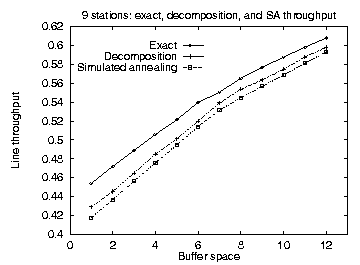 |
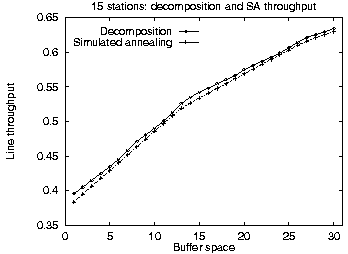 |
In order to evaluate the applicability of the simulated annealing method
to the buffer allocation problem we designed and implemented a system
to calculate the optimum buffer configuration for a given reliable production
line using a simulated annealing algorithm.
The system takes as input:
- the number of production line stations ,
- the available buffer space , and
- the station mean service rates, ,
.
Based on the above input the system calculates the buffer allocations
for the maximal line throughput.
Furthermore, the system is instrumented to provide as part of
the solution the throughput of the suggested configuration, as well as
the number of different configurations that were tried.
The line throughput is used to evaluate the quality of the suggested
configuration when compared with the throughput calculated by other methods.
The number of different configurations tried, is used as an objective
performance criterion, because the configuration evaluation step
is the dominant execution time factor and
the basic building block of all optimisation methods.
The system is based on the simulated annealing algorithm as described in
[PFTV88].
The authors do not clarify that, strictly described, their implementation
is a simulated quenching [Ing93] algorithm
as it uses an exponential cooling schedule.
Our implementation, for efficiency reasons, uses the same exponential
cooling schedule namely:
|  | (7)
|
instead of the standard logarithmic schedule consistent with the
Boltzmann algorithm
The random floating point numbers used for selecting
energy differentials based on the annealing temperature
are produced using the substractive method algorithm
described in [Knu81].
Finally, the evaluative function that we used for calculating
is based on the decomposition method [DF93].
In order to evaluate our method's applicability in selecting line configurations
we run a number of tests on both balanced and unbalanced lines and compared
the simulated annealing results against the results obtained by other
methods.
For short lines and limited buffer space a full enumeration of all
configurations provided an accurate measure when comparing with the simulated
annealing results.
For larger configurations we used a reduced enumeration
in order to provide the comparative measure.
Both methods are subject to the reduced evaluative accuracy of the
decomposition method compared to the Markovian model.
In figure 4 we present the optimum throughput
configurations for balanced lines found using the simulated annealing method
against the throughput found using full (for 9 stations) and reduced
enumeration techniques.
It is apparent that the simulated annealing results follow closely the
results obtained by the other methods.
Figure 5:
Simulated annealing with decomposition evaluation (dash ticks) versus
enumerated Markovian (dot ticks) throughputs for unbalanced lines with
4-6 stations.
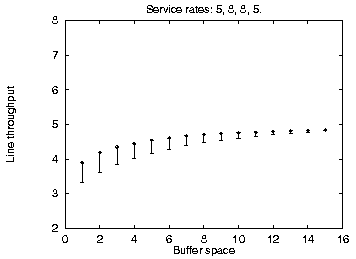 | 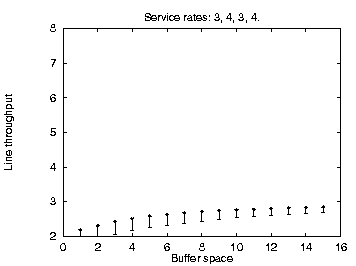 | 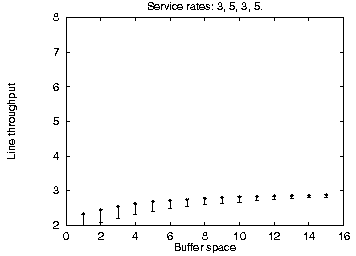 |
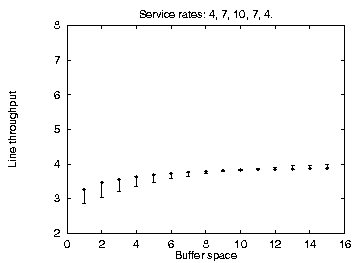 | 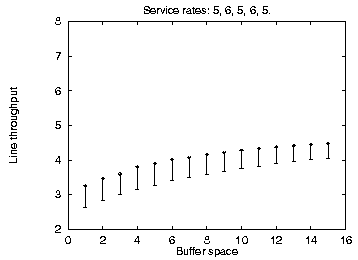 | 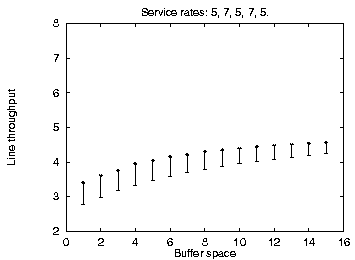 |
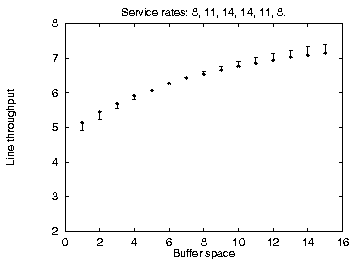 | 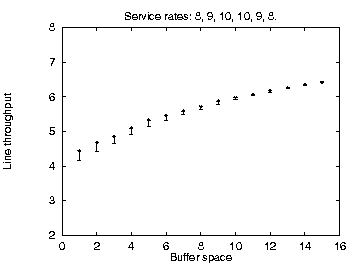 | 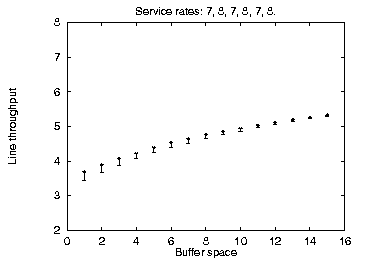 |
In addition to the balanced line evaluation we compared the simulated
annealing method against unbalanced line enumeration using the Markovian
evaluative procedure
for a variety of line sizes, service time configurations, and available
buffer space.
The results are summarised using error bars in figure 5.
It is apparent that the simulated annealing configurations are not always
optimal for limited available buffer space, but they quickly converge
with the optimal configurations as buffer space increases.
This difference can be accounted by the use of the fast decomposition
evaluative procedure in the similated annealing method against the
use of the Markovian evaluative procedure for the enumeration method.
As the decomposition method is not accurate for small sets of unbalanced
lines this is an expected outcome and could be corrected by using the
Markovian evaluation in the simulated annealing optimisation of
small unbalanced production lines.
Figure 6:
Performance of simulated annealing compared with full and reduced
enumerations for 9 stations (left); compared with reduced enumeration
for 15 stations (middle); run for up to 400 stations (right).
Note the scale on the ordinate axis.
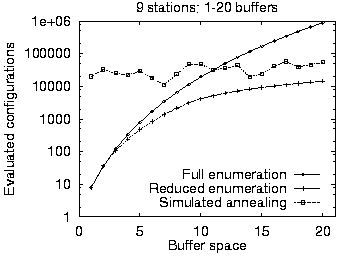 |
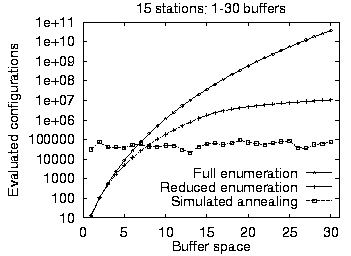 |
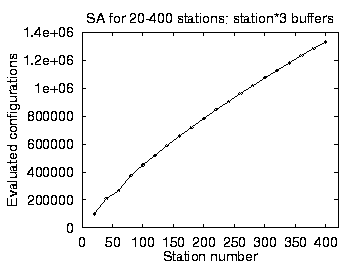 |
Our goal for using the simulated annealing method was to test its
applicability to large production line problems where the cost
of other methods was prohibitevely expensive.
As an example the reduced enumeration method when run on
a 15 station line with a buffer capacity of 30 units took more
than 10 hours to complete on a 100MHz processor.
As shown in figure 6 the cost of the simulated
annealing method is higher than the cost of the full and
reduced enumeration methods for small lines and buffer allocations.
However, it quickly becomes competitive as the number of stations
and the available buffer size increase.
Notice that -- in contrast to the other methods -- the simulated annealing
cost does not increase together with the available buffer space and that it
increases only linearly with the number of stations.
The results obtained using the simulated annealing method to the
reliable line optimal buffer allocation problem are clearly
encouraging.
The performance and the accuracy of the method, although inferior
for optimising small lines with limited buffer space, seem to
indicate clearly that it becomes the method of choice as the problem size
increases.
These characteristics suggest that the method fits nicely together with
the existing optimisation tools satisfying the need for a large production
line optimisation tool.
Further investigation is needed in order to fully evaluate the
method's potential.
The annealing schedule that we used can clearly be optimised potentially
increasing both the method's accuracy and its performance.
Methods such as adaptive simulated annealing [Ing89] can be tried
on the problem set in order to test their applicability.
The use of heuristics in setting up the initial buffer configuration can
decrease the number of steps needed for reaching the optimal.
Other evaluative methods such as the Markovian model can be used in place
of the decomposition algorithm for determining the change differentials.
Furthermore, the small nature of changes made to the configuration during
the annealing process could be taken into account for optimising the
evaluative procedure.
Finally, we would like to test the method's potential on similar
problems especially involving parallel station production lines.
Michael Vidalis implemented the decomposition algorithm and provided us
with the decomposition and reduced decomposition evaluative results.
- Alt97
-
T. Altiok.
Performance Analysis of Manufacturing Systems.
Springer-Verlag, 1997.
- AS93
-
R. G. Askin and C. R. Standridge.
Modeling and Analysis of Manufacturing Systems.
Wiley, 1993.
- BDI95
-
A. A. Bulgak, P. D. Diwan, and B. Inozu.
Buffer size optimization in asynchronous assembly systems using
genetic algorithms.
Computers ind. Engng, 28(2):309-322, 1995.
- BS93
-
J. A. Buzacott and J. G. Shanthikumar.
Stochastic Models of Manufacturing Systems.
Prentice Hall, 1993.
- Cer85
-
V. Cerny.
Thermodynamical approach to the traveling salesman problem: an
efficient simulation algorithm.
Journal of Optimization Theory and Applications, 45:41-51,
1985.
- CMMR87
-
A. Corana, M. Marchesi, C. Martini, and S. Ridella.
Minimizing multimodal functions of continuous variables with the
``simulated annealing'' algorithm.
ACM Transactions on Mathematical Software, 13(3):262-280,
September 1987.
- CMMT88
-
R. W. Conway, W. L. Maxwell, J. O. McClain, and L. J. Thomas.
The role of work-in-process inventories in series production lines.
Operations Research, 36:229-241, 1988.
- DF93
-
Y. Dallery and Y. Frein.
On decomposition methods for tandem queueing networks with blocking.
Operations Research, 41(2):386-399, 1993.
- DG92
-
Y. Dallery and S. B. Gershwin.
Manufacturing flow line systems: A review of models and analytical
results.
Queueing Systems: Theory and Applications, 12:3-94, 1992.
- Egl90
-
R. W. Eglese.
Simulated annealing: A tool for operational research.
European Journal of Operational Research, 46:271-281, 1990.
- Ger94
-
S. B. Gershwin.
Manufacturing Systems Engineering.
Prentice Hall, 1994.
- Glo90
-
F. Glover.
Tabu search -- part I.
ORSA Journal on Computing, 1:190-206, 1990.
- GSB94
-
R. Gupta, S. A. Smolka, and S. Bhaskar.
On randomization in sequential and distributed algorithms.
ACM Computing Surveys, 26(1):7-86, 1994.
- Hol75
-
J. H. Holland.
Adaptation in Natural and Artificial Systems.
University of Michigan Press, Ann Arbor, Michigan, 1975.
- HS91
-
F. S. Hillier and K. C. So.
The effect of the coefficient of variation of operation times on the
allocation of storage space in production line system.
IIE Transactions, 23:198-206, 1991.
- HSB93
-
F. S. Hillier, K. C. So, and R. W. Boling.
Notes: Toward characterizing the optimal allocation of storage space
in production line systems with variable processing times.
Management Science, 39(1):126-133, 1993.
- Ing89
-
L. Ingber.
Very fast simulated re-annealing.
Journal of Mathematical Computation Modelling, 12:967-973,
1989.
- Ing93
-
L. Ingber.
Simulated annealing: Practice versus theory.
Journal of Mathematical Computation Modelling, 18(11):29-57,
1993.
- KAJ94
-
C. Koulamas, S. R. Antony, and R. Jaen.
A survey of simulated annealing applications to operations research
problems.
Omega International Journal of Management Science,
22(1):41-56, 1994.
- KGV83
-
S Kirkpatrick, C. Gelatt, and P. Vecchi.
Optimization by simulated annealing.
Science, 220:671-679, 1983.
- Knu81
-
D. E. Knuth.
The Art of Computer Programming, volume 2 / Seminumerical
Algorithms, pages 171-173.
Addison-Wesley, second edition, 1981.
- LA87
-
P. J. Van Laarhoven and E. H. L. Aarts.
Simulated Annealing: Theory and Applications.
Dordrecht, 1987.
- MRR+53
-
N. Metropolis, A. N. Rosenbluth, M. N. Rosenbluth, A. H. Teller, and H. Teller.
Equation of state calculation by fast computing machines.
Journal of Chemical Physics, 21(6):1087-1092, 1953.
- Per94
-
H. Perros.
Queueing Networks with Blocking.
Oxford University Press, 1994.
- PFTV88
-
W. H. Press, B. P. Flannery, S. A. Teukolsky, and W. T. Vetterling.
Numerical Recipes in C, pages 343-352.
Cambridge University Press, 1988.
- PH96
-
H. T. Papadopoulos and C. Heavey.
Queueing theory in manufacturing systems analysis and design: A
classification of models for production and transfer lines.
European Journal of Operational Research, 92:1-27, 1996.
- PHB93
-
H. T. Papadopoulos, C. Heavey, and J. Browne.
Queueing Theory in Manufacturing Systems Analysis and Design.
Chapman and Hall, 1993.
- Pow92
-
S. G. Powell.
Buffer allocation in unbalanced serial lines.
Working Paper 289, The Amos Tuck School of Business Administration,
Dartmouth College, 1992.
- PV97
-
H. T. Papadopoulos and G. A. Vouros.
A model management system (MMS) for the design and operation of
production lines.
International Journal of Production Research, 1997.
(to be published).
- So97
-
K. C. So.
Optimal buffer allocation strategy for minimizing work-in-process
inventory in unpaced production lines.
IIE Transactions, 29:81-88, 1997.



















